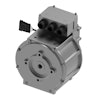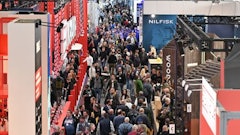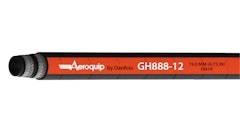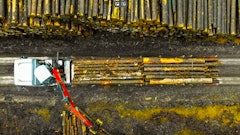Mike Bokulic Jr. likes to think big. The excavation buckets made by his father's company, Mike's Welding Inc. of Fontana, CA, can top 45,000 lbs. and take weeks to fabricate.
Bokulic also thinks big when it comes to designing the buckets. Rather than use mild steel (ASTM grade A36) for the entire shell of the bucket, Mike's Welding uses hardened AR400 steel for the shell and T1 (ASTM grade A514 T1) steel for the lip. The company still relies on the standard A36 mild steel for the ears, the part that serves as the structural point of the bucket, due to its lower tensile strength. AR400 has an extremely high tensile strength, making it prone to cracking. As such, it is not recommended for use as a structural component on heavy equipment.
As a result of the material choices and specialized fabrication, the buckets from Mike's Welding cost a little more but may save customers money through longer life spans and reduced downtime.
The company applies the same cost principles to its choice of filler metals. For years, Mike's Welding relied on a less expensive, self-shield flux-cored wire (AWS classification E70T-4). That is, until it applied a big picture approach and discovered that metal-cored wire could help create a higher quality product and save more money in the long run. Like the company's buckets, metal-cored wire costs slightly more per unit (it also requires additional costs for gas), however, the benefits more than justify the upfront expense.
By switching from a flux-cored wire to Hobart Brothers' Tri-Mark Metalloy 110 gas-shielded, metal-cored wire, Mike's Welding cut approximately eight man-hours from its bucket fabrication (for a 13-yd. bucket) and has virtually eliminated expensive warranty rework on cracks along the welds. The result has been a 10% increase in productivity and a savings of approximately $560 in labor costs for a 13-yd. bucket.
Quality is Priority One
As a seven-person company whose livelihood depends on quality performance, it is aware of the impact a few defective products can have on the business. "A family-owned business is a lot different than larger production companies," Bokulic says. "It's hands-on. It's your name. It's your reputation. It's everything."
There was a lot of frustration when the company started seeing cracks forming along the welds of its buckets while working in the field.
"When we used flux-cored wire, we were experiencing cracking problems at the edge of the plate where it was beveled, and the crack would shoot down right through the welds," Bokulic says.
Even though Mike's Welding had (and has) a flexible, pragmatic warranty policy in place to manage problems such as cracking, that policy, along with the company's customer-centered attitude (the company repairs defective parts long past the industry standard of 90 days), both came at a price.
Some of the company's larger buckets cost $5,000 or more to ship back to its repair facility. If a customer opted for onsite repairs, Mike's Welding needed to hire welders. In addition to the shipping and repair expenses, Bokulic knew the impact that defective products could have on the reputation of the business.
Making the switch
Mike's Welding was first alerted to the possibility of using metal-cored wire after discussing some of the cracking issues with their welding supplier, Patrick Gonzalez of California Tool and Welding Supply.
"We talked with Mike, and he was interested in learning more about it, so we got in touch with Ed Bogner, Miller Electric and Hobart Brothers district manager to verify that a metal-cored wire would work with its applications," Gonzalez says.
With Gonzalez and Bogner's help, welding fabricators tested Metalloy 110 in 1/16 in. dia. on some of the smaller buckets. Once they were able to figure out the right gas mixture for their needs — 90% Argon and 10% CO2—and become comfortable welding with metal-cored wire, Mike's Welding knew it was onto something.
According to Bokulic, the first difference fabricators noticed with the Metalloy 110 was the weld bead appearance, which he says "is like night and day" compared to the flux-cored wire.
The primary reason for the difference in weld bead appearance is that metal-cored wire operates in a spray transfer mode and does not produce slag like flux-cored wires do. The combination of those two factors provides welding fabricators with a flatter, spatter-free, washed-in weld. But more importantly, it eliminates the time and costs needed for chipping slag between welding passes.
Welding fabricators noticed other benefits, as well. Because metal-cored wire contains fine particles of a proprietary metal blend surrounded by a metal sheath, it has a higher deposition efficiency than a flux-cored wire. Such features translate to higher deposition rates, which result in faster travel speeds at equivalent amperage settings. More metal-cored wire ends up in the weld compared to flux-cored wire, which loses a portion to slag, and welding fabricators can weld faster.
Final results
After making the switch to Metalloy 110, Mike's Welding saw appreciable difference in the costs related to both the fabrication of its buckets and to its customer-centered warranty policies.
For example, fabricating a 13-yd. bucket takes approximately 60 to 80 man-hours. Some of that time includes pre-heating the AR400 steel (250 to 400 F depending on its thickness) to help protect against rapid cooling that could lead to cracking. While Mike's Welding still applies pre-heat when welding with Metalloy 110, it has eliminated a significant portion of its post-weld activities.
Using flux-cored wire, welding fabricators spent approximately six hours cleaning slag and grinding spatter from the finished product. The bucket would then undergo approximately two hours of full cleanup (often additional grinding of spatter) for paint preparation. Since implementing the metal-cored wire, welding fabricators have eliminated these post-weld activities completely. At an overhead of $70 per hour for labor, ridding the company of eight hours of labor per bucket means significant savings.
But perhaps the biggest benefit of the new metal-cored wire has been the considerable reduction in the cracking problems, and with it, excessive warranty costs.
"We haven't had many issues since we switched to the metal-cored wire," Bukolic says. "The Metalloy is more expensive than the flux-cored wire we were using, but it's been well worth it in the long run."
According to Bogner, companies such as Mike's Welding, which measure the long-term benefits of spending more upfront when fabricating a product, can reap the return on investment for both the company and the customers.
"If you only base your expenses on the cost of the actual product, that's not the full figure," explains Bogner. "Labor is usually the No. 1 expense in fabricating a product. If we can reduce labor by increasing travel speeds and eliminating slag chipping, it's going to save everyone a lot of money."
Minimizing rework and repairs, whether they occur when a bucket is shipped to Mike's Welding or when they pay for onsite repairs, adds to that savings.
As Mike's Welding has learned through the transition from flux-cored to metal-cored wire, a short-term approach may result in short-term cost savings, but over time the savings can be negated through warranty repairs and increased production costs.
From his own experience, Bukolic recommends companies take a big picture approach to their fabricating process. By doing so, they may realize that spending a little more for a product that better serves their needs will pay long-term dividends and result in more satisfied customers.
Tim Hensley is distribution support manager, tubular wire, for Hobart Brothers and Ed Bogner is district manager for Miller Electric Mfg. Co.















